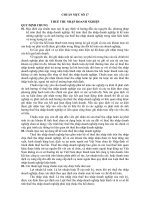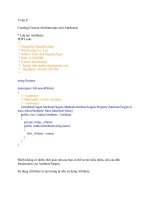Tài liệu Constituent Structure - Part 17 doc
Bạn đang xem bản rút gọn của tài liệu. Xem và tải ngay bản đầy đủ của tài liệu tại đây (118.51 KB, 10 trang )
(10) (a) * I wrote on [
NP
the big pad of paper] not [
NP
one].
(b) I wrote on this [
N’
big pad of paper] not that [
N’
one].
(c) I wrote on the big [
N’
pad of paper] not the small [
N’
one].
(d) * 4I wrote on the big [
N
pad] of sketch paper not the big [
N’
one]
of newsprint.
If these operations do indeed target only N’ (rather than say a vaguer
notion of ‘‘node’’ or ‘‘constituent’’) then this would be evidence against
Speas’s proposal. She observes, however, that a more careful probing of
the data shows that the apparent X’ limiting character of these replace-
ment rules is actually epiphenomenal. Building upon some observa-
tions of Travis (1984), she shows that ungrammatical forms such as
(10d) follow from case and theta theories, and that the rules of re-
placement are more liberal than they Wrst appear. Do-so replacement
fails to apply exactly in the environments where a Case needs to be
assigned to the complement:
(11) (a) *I bought a car and Andrew did so a truck.
(b) I ate at the restaurant and Andrew did so at the museum.
Travis and Speas claim that do so is a pro-verb that lacks theta and
Case-assigning properties. This explains why it cannot replace a V’ in
contexts where there is a complement, because complements typically
require a theta role and/or Case. A similar analysis can be given to one-
replacement. Consider the contrast in (12), taken from Speas (1990: 41).
(12) (a) *the student of chemistry and the one of physics
(b) the picture of Julia and the one of Suzanne
Speas argues that the of in (12a) is a case marker, but the one in (12b) is
a full preposition. This contrast can be further exempliWed by the fact
that of-phrases like those in (12b) can follow the verb to be (13b), but
the one in (12a) cannot (13a). The of in (13b) parallels the behavior of
other full predicative prepositions, which can all follow to be. As such
these PPs do not get a theta role (they are predicates), and do not need
independent Case licensing (they get their case from the preposition).
By contrast, the of-PP in (13a) can not function predicatively, suggest-
ing that it needs a theta role, and presumably Case licensing.5
4 As noted before, not all speakers of English will Wnd this ungrammatical. However,
judgments are fairly uniformly negative for the equivalent form using do-so replacement:
*I ate the peanuts, John did so the apples.
5 For an alternative view of these facts see Harley (forthcoming).
140 controversies
(13) (a) *This student is of Physics.
(b) This picture is of Suzanne. (Speas 1990: 42)
If we take the of in (12a) to be a Case marker, then the ungrammatic-
ality of (12a) follows from the same mechanism suggested for do-so
replacement: one is a pro-form that cannot assign Case or theta role to
its complement. The ungrammaticality of (12a) is not due then to the
fact that we are replacing an N8 (which we see is allowed in (12b)), but
due to the fact that the complement of one lacks a theta role and is
Caseless.
With this analysis in hand we can see that no rules appear to make
direct reference to the single bar level. (Rules like one-replacement and
do so-replacement target a variety of node types, but are constrained by
other parts of the grammar, such that in the default situation it appears
as if they target only the single bar level.) This lends plausibility to
Speas’s claim that bar levels are not featural and not marked as
primitives on the tree. Instead, constituents are unmarked for any
kind of bar level. Rules that make reference to the XP or X8 status of
a constituent do so to a derived notion that is calculated relative to the
rest of the tree.
This approach has important consequences for our understanding
of adjuncts. If single-bar levels aren’t formally distinguished, then the
deWnition of adjunct as a daughter of a single bar and sister to a
single bar level is impossible. Similarly, deWning adjuncts in terms
of Chomsky adjunction (14) is impossible, since only the topmost
projection could get the XP label, the lower one could not.
() Chomsky adjunction
YP
XP
XP
adjunct ZP XЈ
There is evidence to suggest, however, that adjuncts may deserve some
alternative treatment in any case. Van Riemsdijk and Williams observe
a set of facts most thoroughly treated in Lebeaux (1988): there appears
to be variation in the way the binding theory applies to adjuncts.
Consider the noun John in the following sentences, and whether or
not it is subject to Condition-C eVects.
(15) (a) * He
i
believes [the claim that John
i
is nice]
(b) *[Whose claim that John
i
is nice]
k
did he
i
believe t
k
?
set-theoretic constituency 141
(c) *He
i
likes [the story that John
i
wrote].
(d) [Which story that John
i
wrote]
k
did he
i
like t
k
? (Lebeaux
1988: 146)
(15a and c) exhibit condition C eVects. The R-expression John is
c-commanded and bound by the coindexed pronoun he. Sentence
(15b) shows that this is true even when the R-expression is contained
in a wh-phrase that has been moved to the front of the sentence. The
usual analysis of (15b) is that either binding condition C holds at
D-structure before wh-movement applies or the wh-phrase ‘‘recon-
structs’’ to its D-structure position after the overt component of the
grammar. Sentence (15d) is the surprising case, as the R-expression in
the fronted wh-phrase does not seem to be subject to condition C, in
contrast with (15b). These cases are known in the literature as ‘‘anti-
reconstruction sentences.’’ The diVerence between the (b) and (d)
sentences lies in the nature of the clause containing the R-expression;
in (15b) it is a complement to the noun claim, but in (15c) the CP is an
adjunct6 on story.
(15Ј)
(a)
……(b)
NЈ NЈ
NCPNЈ CP
N
Lebeaux explains these facts by timing operations at diVerent levels.
Simple X-bar construction, except for adjuncts, applies at D-structure
before any movement. Condition C holds at this level, resulting the
unacceptability of (15a and b). Adjunction is a separate operation,
adjuncts are added after D-structure and movement.
(16) X Bar À! D-Structure
#
Movement
#
S-Structure (adjunction happens here)
So the derivation of (15d) is such that the adjunct is added after the
wh-phrase has moved past the pronoun:
6 There is a class of adjuncts that do not exhibit anti-reconstruction eVects. Speas shows
that these seem to have semi-argument status, and thus will be present at D-structure in
order to meet the theta criterion. We leave this class aside for the discussion here.
142 controversies
(17) (a) He liked [which story] D-structure
(b) [which story] did he like wh-movement
(c) [which story that John wrote] did he like Adjunction
The sentence is predicted to be well-formed since there is never a point
in the derivation where John is c-commanded by he. The adjunct in
(15c) is presumably added after D-structure as well, so the ungram-
maticality of (15c) requires one further assumption: condition C also
holds at S-structure. Sentence (15d) is not ruled out by this extra
assumption since the R-expression, being inserted directly into the
surface position of the wh-phrase, is never c-commanded by the
pronoun, even at S-structure. This suggests that adjuncts are not part
of the X-bar schema, at least at D-structure. See Chametzky (1995) for
further discussion of these facts.
Bobaljik (1994) makes a related observation, although he accounts
for it in a very diVerent way. His focus is on the old observation that
negation and subject arguments that occur between InX/T and the verb
trigger do-insertion, but adjuncts do not:
(18) (a) Andrew (InX)pa
id his rent.
(b) Andrew d
id not pay his rent.
(b) D
id Andrew pay his rent?
(c) Andrew (InX) frequently pa
id his rent.
In Bobaljik’s system, English verb inXection attaches rightwards to the
verb through ‘‘merger under adjacency’’. This is a morphological oper-
ation that looks at the linear string. In (18a), the past tense features on InX
are adjacent to the verb, so undergo merger, showing up as the suYx-ed.
In (18b and c) this adjacency is blocked by the intervening negation and
the intervening subject respectively, so do is inserted to support the
inXection. What is surprising is the behavior of adverbs in (18d), which
do not appear to block adjacency, and no do-support is found. Bobaljik is
one of many to suggest that this follows from a multi-tiered or three
dimensional tree structure, where adjuncts are not immediately part of
the same hierarchy as the arguments and heads, and stand oV from the
relationships that count for ‘‘adjacency’’. We return in some detail to
multi-tiered and three dimensional trees in Chapter 10. Bobaljik’s analysis
is consistent with Speas’s claim that adjuncts are not distinguished by
virtue of where they stand relative to any given bar level. For related
arguments see Lasnik (1998), Nissenbaum (1998), Bos
ˇ
kovic
´
and Lasnik
(1999), Ochi (1999), and Stepanov (2001).
set-theoretic constituency 143
Speas’s system makes a number of other interesting predictions
about the nature of constituent structures. Among other things, vacu-
ous projections (i.e. those with no branching) are ruled out. So bare Ns
(and other non-branching nodes) have a simple single-node structure:
() (a) X-bar theory (b) relativized approach
IP Infl
NP IЈ N
He
Infl
NЈ Infl
will
VP
Infl
will
V
run
N
He
VЈ
V
run
As we will see below in section 8.4, when we look at Chomsky (1995b),
this makes some interesting predictions about clitics and other struc-
tures with ambiguous phrasality.
Bouchard (1995) and Chametzky (1995) make some claims about
constituency that are similar to Speas’s but with diVerent motivations.
Bouchard claims that all properties of phrase structure should follow
from the argument structure/semantics of heads. This proposal is a
small step away from a dependency grammar (see Ch. 9), a trend that
we will see repeated below several times.
8.3 Antisymmetry
The next major revision to X-bar theory is found in Kayne’s (1994) book
The Antisymmetry of Syntax. Kayne’s main concern is the relation of
linear precedence. Precedence (and linear order in general) is obviously
an important part of syntax. However, rules that make reference exclu-
sively to precedence (without also making reference to some kind of
hierarchical relation) are extremely rare (the case of do support discussed
by Bobaljik being an exception). If you will recall from Chapter 3,the
deWnition of precedence is quite convoluted and complicated. This
suggests that precedence relations might also be secondary and derived
notions. One such proposal is found in Travis (1984), where she argued
that precedence relations were really a matter of the interaction of a set of
parameter settings (including headedness, case and thematic direction-
ality). Kayne oVers a very diVerent approach. He claims that, universally,
144 controversies









